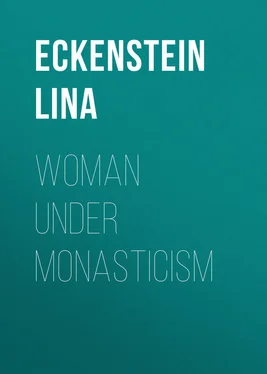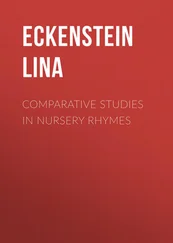Lina Eckenstein - Woman under Monasticism
Здесь есть возможность читать онлайн «Lina Eckenstein - Woman under Monasticism» — ознакомительный отрывок электронной книги совершенно бесплатно, а после прочтения отрывка купить полную версию. В некоторых случаях можно слушать аудио, скачать через торрент в формате fb2 и присутствует краткое содержание. Жанр: История, foreign_antique, foreign_prose, на английском языке. Описание произведения, (предисловие) а так же отзывы посетителей доступны на портале библиотеки ЛибКат.
- Название:Woman under Monasticism
- Автор:
- Жанр:
- Год:неизвестен
- ISBN:нет данных
- Рейтинг книги:4 / 5. Голосов: 1
-
Избранное:Добавить в избранное
- Отзывы:
-
Ваша оценка:
- 80
- 1
- 2
- 3
- 4
- 5
Woman under Monasticism: краткое содержание, описание и аннотация
Предлагаем к чтению аннотацию, описание, краткое содержание или предисловие (зависит от того, что написал сам автор книги «Woman under Monasticism»). Если вы не нашли необходимую информацию о книге — напишите в комментариях, мы постараемся отыскать её.
Woman under Monasticism — читать онлайн ознакомительный отрывок
Ниже представлен текст книги, разбитый по страницам. Система сохранения места последней прочитанной страницы, позволяет с удобством читать онлайн бесплатно книгу «Woman under Monasticism», без необходимости каждый раз заново искать на чём Вы остановились. Поставьте закладку, и сможете в любой момент перейти на страницу, на которой закончили чтение.
Интервал:
Закладка:
The Acts of the Saints, the comprehensive collection of which is now in course of publication under the auspices of the Bollandists, form a most important branch of literature. They include some of the most valuable material for a history of the first ten centuries of our era, and give a most instructive insight into the drift of Christianity in different epochs. The aims, experiences and sufferings of Christian heroes and heroines inspired the student and fired the imagination of the poet. Prose narrative told of their lives, poems were written in their praise, and hymns were composed to be sung at the celebration of their office. The godly gained confidence from the perusal of such compositions, and the people hearing them read or sung were impressed in favour of Christian doctrine.
The number of men and women whom posterity has glorified as saints is legion. Besides the characters of the accepted and the apocryphal gospels, there are the numerous early converts to Christianity who suffered for their faith, and all those who during early Christian times turned their energies to practising and preaching the tenets of the new religion, and to whose memory a loving recollection paid the tribute of superstitious reverence. Their successors in the work of Christianity accepted them as patron saints and added their names to the list of those to whose memory special days were dedicated. Many of them are individuals whose activity in the cause of Christianity is well authenticated. Friends have enlarged on their work, contemporary history refers to their existence, and often they have themselves left writings, which give an insight into their lives. They are the early and true saints of history, on whose shoulders in some cases the cloak of heathen association has fallen, but without interfering with their great and lasting worth.
But besides those who were canonised for their enthusiasm in the cause of early Christianity, the Acts of the Saints mention a number of men and women who enjoy local reverence, but of whose actual existence during Christian times evidence is wanting. Among them are a certain number of women with whom the present chapter purposes to deal, women who are locally worshipped as saints, and whose claims to holiness are generally recognised, but whose existence during Christian times is hypothetical. Their legends contain a small, in some cases a scarcely sensible, basis of historic fact, and their cult preserves traits which are pre-Christian, often anti-Christian, in character.
The traveller Blunt, during a stay in Italy in the beginning of this century, was struck with the many points which modern saints and ancient gods have in common. He gives a description of the festival of St Agatha at Catania, of which he was an eye-witness, and which to this day, as I have been told, continues little changed. The festival, as Blunt describes it, opened with a horse-race, which he knew from Ovid was one of the spectacles of the festival of the goddess Ceres; and further he witnessed a mummery and the carrying about of huge torches, both of which he also knew formed part of the old pagan festival. But more remarkable than this was a great procession which began in the evening and lasted into the night; hundreds of citizens crowded to draw through the town a ponderous car, on which were placed the image of the saint and her relics, which the priests exhibited to the ringing of bells. Among these relics were the veil of Agatha, to which is ascribed the power of staying the eruption of Mount Aetna, and the breasts of the saint, which were torn off during her martyrdom 33 33 Blunt, J. J., Vestiges of Ancient Manners in Italy and Sicily , 1823, pp. 56 ff.
. Catania, Blunt knew, had always been famous for the worship of Ceres, and the ringing of bells and a veil were marked features of her festivals, the greater and the lesser Eleusinia. Menzel tells us that huge breasts were carried about on the occasion 34 34 Menzel, W., Christl. Symbolik , 1854, article ‘Brust,’ makes this statement. I do not see where he takes it from.
. Further, Blunt heard that two festivals took place yearly in Catania in honour of Agatha; one early in the spring, the other in the autumn, exactly corresponding to the time when the greater and lesser Eleusinia were celebrated. Even the name Agatha seemed but a taking over into the new religion of a name sacred to the old. Ceres was popularly addressed as Bona Dea , and the name Agatha, which does not occur as a proper name during ancient times, seemed but a translation of the Latin epithet into Greek.
The legend of Agatha as contained in the Acta Sanctorum places her existence in the third century and gives full details concerning her parentage, her trials and her martyrdom; but I have not been able to ascertain when it was written. Agatha is the chief saint of the district all about Catania, and we are told that her fame penetrated at an early date into Italy and Greece 35 35 A. SS. Boll. , St Agatha, Feb. 5.
.
It is of course impossible actually to disprove the existence of a Christian maiden Agatha in Catania in the third century. Some may incline to the view that such a maiden did exist, and that a strange likeness between her experiences and name on the one hand, and the cult of and epithet applied to Ceres on the other, led to the popular worship of her instead of the ancient goddess. The question of her existence as a Christian maiden during Christian times can only be answered by a balance of probabilities. Our opinion of the truth or falsehood of the traditions concerning her rests on inference, and the conclusion at which we arrive upon the evidence must largely depend on the attitude of mind in which we approach the subject.
The late Professor Robertson Smith has insisted that myths are latter-day inventions which profess to explain surviving peculiarities of ritual. If this be so, we hold in the Eleusinia a clue to the incidents of the Agatha legend. The story for example of her veil, which remained untouched by the flames when she was burnt, may be a popular myth which tries to account for the presence of the veil at the festival. The incident of the breasts torn off during martyrdom was invented to account for the presence of these strange symbols.
Instances of this kind could be indefinitely multiplied. Let the reader, who wishes to pursue the subject on classic soil, examine the name, the legend and the emblem of St Agnes, virgin martyr of Rome, who is reputed to have lived in the third century and whose cult is well established in the fourth; let him enquire into the name, legend and associations of St Rosalia of Palermo, invoked as a protectress from the plague, of whom no mention occurs till four centuries after her reputed existence 36 36 A. SS. Boll. , St Agnes, Jan. 21; St Rosalia, Sept. 4.
.
I have chosen Agatha as a starting point for the present enquiry, because there is much evidence to hand of the prevalence of mother-deities in pre-Christian Sicily, and because the examination of German saint-legend and saint-worship leads to analogous results. In Germany too the mother divinity of heathendom seems to survive in the virgin saint; and in Germany virgin saints, in attributes, cult and name, exhibit peculiarities which it seems impossible to explain save on the hypothesis that traditions of the heathen past survive in them. So much is associated with them which is pre-Christian, even anti-Christian in character, that it seems legitimate to speak of them as pseudo-saints.
I own it is not always possible to distinguish between the historical saint and the pseudo-saint. Sometimes data are wanting to disprove the statements made by the legend-writer about time and place; sometimes information is not forthcoming about local traditions and customs, which might make a suggestive trait in saint-legend stand out in its full meaning. In some cases also, owing to a coincidence of name, fictitious associations have become attached to a real personage. But these cases I believe are comparatively few. As a general rule it holds good that a historical saint will be readily associated with miraculous powers, but not with profane and anti-Christian usages. Where the latter occur it is probable that no evidence will be forthcoming of the saint’s actual existence during Christian times. If she represents a person who ever existed at all, such a person must have lived in a far-distant heathen past, at a time which had nothing in common with Christian teaching and with Christian tenets.
Читать дальшеИнтервал:
Закладка:
Похожие книги на «Woman under Monasticism»
Представляем Вашему вниманию похожие книги на «Woman under Monasticism» списком для выбора. Мы отобрали схожую по названию и смыслу литературу в надежде предоставить читателям больше вариантов отыскать новые, интересные, ещё непрочитанные произведения.
Обсуждение, отзывы о книге «Woman under Monasticism» и просто собственные мнения читателей. Оставьте ваши комментарии, напишите, что Вы думаете о произведении, его смысле или главных героях. Укажите что конкретно понравилось, а что нет, и почему Вы так считаете.












